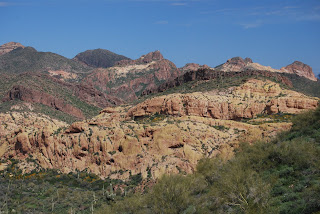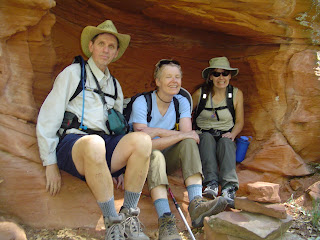




 QUARTZ PEAK
QUARTZ PEAK
Sierra Estrella Wilderness
Rising out of the Rainbow Valley along a desert ridge, the rugged Quartz Peak trail gains elevation aggressively. The route hugs a "saw tooth edge" along the spine of the ridge with deep valleys and incredible views on each side. The first two miles follow an established trail, but after that, only sporadically-placed rock carins indicate the way through boulders, shimmering mica and rough-hewn, metamorphic rock formations. As a rule of thumb, if you think you have lost the trail, just go up. The path is truly on top of the ridge, and yes, that means quite a bit of rock scrambling is required. Gaining the summit requires negotiating 50-feet of hand-over-foot (non-technical) climbing. An outcropping of snowy-white quartz caps the 4,052-foot apex where views of metro Phoenix and the surrounding desert plains beg to be photographed.
LENGTH: 6 miles out-and-back
RATING: difficult
ELEVATION: 1,552 - 4,052 feet
GETTING THERE: NOTE: a hiker reports that on 11-10-2012, construction at the phone line road made for a very rough crossing, however, they got thru okay.
From Phoenix, take I-10 west to exit 126 and turn left onto Estrella Parkway. Drive 8.3 miles and turn right onto Elliot Road. Continue 2.6 miles and turn left onto Rainbow Valley Road. Proceed 9.3 miles to Riggs Road and turn left. Drive another 3.9 miles to Bullard Ave. and turn right and then make an immediate left onto an unmarked dirt road that parallels some phone lines. Follow the dirt road 5.3 miles and turn right at the "T" intersection where a tiny sign points towards a "trail". Continue for two miles and turn left at another generic trail sign and drive 1.9 miles to the trailhead.
FACILITIES: restrooms
INFORMATION: http://www.blm.gov/az/st/en/prog/recreation/hiking/quartz.html



 HAT TOP HILL
Goldfield Mountains
Often overshadowed by their famous neighbors--the Superstition Mountains--the equally interesting Goldfield Mountains also offer outstanding hiking opportunities. That is, of course, if you can manage to find your way around on the confusing maze of old roads and faint paths that provide access to the area. Without a good map and sound route finding skills, it's virtually impossible to stay on track in the Goldfields. In March of 2008, I was fortunate enough to participate in a Sierra Club outing led by Ted Tenny, author of Goldfield Mountain Hikes (Gem Guides, 2006). It was a memorable adventure and a highly recommended destination. However, due to the complexity of the route, I will defer to Ted's book and website for maps and route information. Visit Ted at mile240.us/Goldfields/index.html
HAT TOP HILL
Goldfield Mountains
Often overshadowed by their famous neighbors--the Superstition Mountains--the equally interesting Goldfield Mountains also offer outstanding hiking opportunities. That is, of course, if you can manage to find your way around on the confusing maze of old roads and faint paths that provide access to the area. Without a good map and sound route finding skills, it's virtually impossible to stay on track in the Goldfields. In March of 2008, I was fortunate enough to participate in a Sierra Club outing led by Ted Tenny, author of Goldfield Mountain Hikes (Gem Guides, 2006). It was a memorable adventure and a highly recommended destination. However, due to the complexity of the route, I will defer to Ted's book and website for maps and route information. Visit Ted at mile240.us/Goldfields/index.html



















































